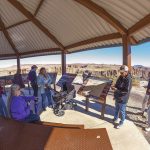
50 Years Ago: Times tries its hand at teaching Navajo
The Navajo Times began something in December 1966 that could have been a game changer.
The paper didn’t promote it very well and started it with just a couple of paragraphs of explanation but what they did was something no other tribal newspaper had ever attempted before.
Several years later, Chet Macrorie, who was editor of the Navajo Times, talked about it and said when it was proposed to him by tribal education officials, he immediately saw its value and agreed to make it a regular part of the paper.
What he approved was a regular column that taught non-Navajo speaking Navajos how to speak the language.
Tribal educators were growing alarmed at the number of Navajo children who were not being brought up speaking the language. At the time, they estimated that one out of every five Navajos under the age of five did not know their language or only knew a few words or phrases.
These were children being brought up in the major Navajo communities or in border towns.
Except for a couple of schools on the reservation, no public or BIA school was teaching the Navajo language and tribal educators were discovering that a lot of Navajo families were speaking primarily English in their households and were not teaching their children the Navajo language because they wanted them to be able to live within the Anglo culture because that’s where the jobs were.
This was creating a situation, educators said, where many children were not able to communicate with their grandparents who spoke mostly Navajo and had limited ability to speak English.
The lessons in the paper, titled “Navajo Made Easier,” took up about a third of the tabloid-sized page and would deal with how to greet your aunt in Navajo or how to address someone in Navajo who showed up to your door.
The problem was that it took some pre-knowledge on the part of the person learning Navajo to get the pronunciation right, but the paper urged people interested in learning the language to go over the lesson with a Navajo-speaking relative or friend.
The lessons would continue for almost a year and the paper received a lot of praise for the effort although Macrorie said it was hard to determine if it actually was good enough to teach someone the language.
What it did do, he said, was spur a lot of Navajos and a few non-Navajos to think seriously about taking classes in Navajo that were being offered by various groups.
A decade and a half later, the Times tried another experiment with the help of the tribal Diné Language program, which would be given a full page to provide stories in Navajo as well as to promote the language.
This again resulted in the paper being praised for trying to help preserve the language, but it too was abandoned too soon.
This also wasn’t given a lot of attention – in fact the story appeared on Page 10 beneath a story on the United Indian Traders Association electing Russell Foutz, a renounced trader in rugs, as its president.
The association had been around for a number for years and had more than 100 members, almost all non-Indian, who would meet annually to talk about the trading and renew friendships.
The meeting this year was held in Flagstaff and one of the main areas of discussion was problems.
A number of traders were getting to the final years of their 25- or 30-year leases and were reporting have some problems with the tribe and the BIA getting them renewed again.
Many chapters were complaining about the prices at some of the trading posts and feeling that the traders were making too much money off of Navajos who had limited consumer skills.
Most traders had made tens of thousands, or in some cases, hundreds of thousands of dollars in improvements to their stores over the years and if they lost their leases, they would be forced to leave their businesses without getting any kind of compensation for the work or the money they put into them.
This was just the beginning of the efforts by many chapters to have the leases turned over to Navajos to have them run the trading posts and by the end of the decade, a large majority of the Anglo traders were making arrangements to sell their businesses to Navajos before their leases were taken away from them.
It would only be a couple of years before trading posts on the reservation would be hit by fires that would destroy entire structures.
The odd thing was that these fires were taking place at times when traders were trying to get their leases extended and some suspected that many of these fires may have been started by the traders themselves so they would be able to collect on their insurance and get back some of the money they spent on improving the place.
To read the full article, pick up your copy of the Navajo Times at your nearest newsstand Thursday mornings!
Are you a digital subscriber? Read the most recent three weeks of stories by logging in to your online account.








 Highway 264,
Highway 264, I-40, WB @ Winslow
I-40, WB @ Winslow